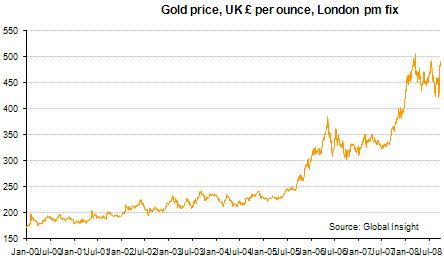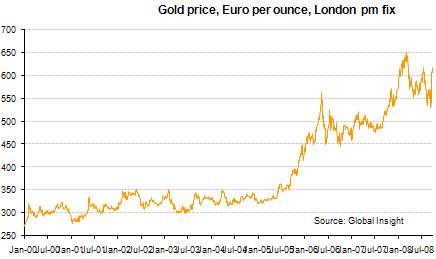
Greenspan: Gold is "the Ultimate Form of Payment in the World" due to "Fiat Money in Extremis"
Mark O'Byrne, Executive Director
Gold fell yesterday as the dollar rallied ( gold closed at $874.00 down $14.4 0 while silver closed at $12.18 down 75 cents ). In after hours trading there was determined selling which pushed the price as low as $860 prior to rallying above the New York close and as high as over $883/oz.
In the titanic battle between the gold bulls and the gold bears, the gold bears and powerful selling entities have again won the short term battle. But this looks set to be another pyrrhic victory as the shorts are likely to get their heads handed to them on a plate when gold's supply demand fundamentals (as seen in many articles in recent days and in the Financial Times articles today - see our News section and below) which become more bullish by the day, ultimately overwhelm the short sellers.
Gold would appear to be well supported at the $850/oz to 860/oz level but anything is possible given the unprecedented nature of the volatil ity in global money markets . However, with interbank rates continuing to rise to new record levels, systemic risk remains elevated which will support gold.
Gold , unlike all other asset classes, is up some 1 7 % in the last 3 weeks ( since it's recent Sept e mber 11th lows it has gone from $750 /oz to $87 8/oz today ) and may need to consolidate between $850 and $910 prior to rechallenging $1,000/oz in the coming weeks.


Gold remains very firm and near recent record highs in Euros and GBP as these currencies have weakened significantly in recent weeks. We have not witnessed the dollar strengthening rather all fiat currencies weakening vis a vis the dollar as contagion has spread from the original epicentre in the US to financial systems and economies internationally.
Greenspan: Gold is "the Ultimate Form of Payment in the World"
The Financial Times' Javier Blas has written two excellent articles examining the surging demand for gold amid a growing lack of supply ('Investors start fresh Gold Rush' and ' Wealthy investors hoard bullion') <see News section of homepage>.
In them he outlines how "investors in gold are demanding “unprecedented” amounts of bullion bars and coins and moving them into their own vaults as fears about the health of the global financial system deepen."
He astutely notes Alan Greenspan's observations regarding fiat paper money and the value of gold as being the "ultimate form of payment in the world"
" “Fiat money, in extremis, is accepted by nobody,” Alan Greenspan, the former chairman of the US Federal Reserve, told lawmakers in Washington almost a decade ago. “Gold is always accepted,” he added.
The “in extremis” scenario was for years only a possibility in the mind of die-hard gold bugs, but the financial crisis is leading regular investors – from the ultra-rich to middle-class savers – to believe that the environment in which Mr Greenspan said fiat money would be worthless is now around the corner. . . .
The investors' response is a rush into physical gold not seen since the second oil crisis in 1979, bankers say. The shift into gold coins and bars is so extreme that it is causing shortages at refineries and mints around the world. "
W ith the Federal Reserve and global central banks injecting thousands of billions of dollars, euros, pounds, yen and swiss francs (primarily dollars though) into the global financial system in order to prevent a systemic meltdown and contagion, a degree of monetary debasement is taking place that has not been seen in wealthy industrialised economies since Germany's Weimar Republic's money printing in order to pay off World War I debt reparations. This led to hyperinflation and destruction of the German mark and economy and the rise of the Nazis.
The scale of the money printing today is more akin to that seen in badly mismanaged less developed countries such as Argentina and other South American and African countries in the late 20th century. The fiscal ramifications of the money printing are massive and yet to be realised.
A more recent example of massive money printing is Zimbabwe, one of Africa's most prosperous nations until recently, which is now suffering from a crushing hyperinflation, last reported to be at 11.2 million percent. The Zimbabwean central bank has unveiled a series of ever-larger notes since August, when it struck 10 zeros off the local currency that had become so weak that billions of dollars were required just to buy a loaf of bread.
Few are suggesting that America will go the way of Zimbabwe, but the present bout of "fiat money in extremis" risks a severe bout of stagflation that would make the stagflation of the 1970's look positively benign.
By Mark O'Byrne, Executive Director
| Gold Investments 63 Fitzwilliam Square Dublin 2 Ireland Ph +353 1 6325010 Fax +353 1 6619664 Email info@gold.ie Web www.gold.ie |
Gold and Silver Investments Limited No. 1 Cornhill London, EC3V 3ND United Kingdom Ph +44 (0) 207 0604653 Fax +44 (0) 207 8770708 |
www.marketoracle.co.uk/Article6569.html
